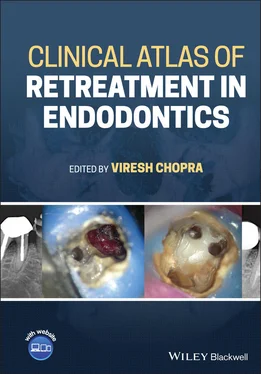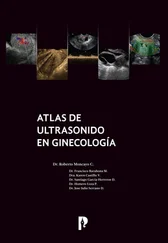1 Cover
2 Title Page
3 Copyright Page
4 Foreword
5 Preface
6 Acknowledgments
7 List of Contributors
8 List of Abbreviations
9 About the Companion Website
10 Introduction to endodontic retreatment I.1 Definition I.2 Rationale for retreatment I.3 Aim of endodontic retreatment References
11 1 Clinical Case 1 – Perforation repair 1.1 Patient information 1.2 Tooth 1.3 Treatment plan 1.4 Technical aspects 1.5 Follow‐up 1.6 Learning objectives 1.7 How can this endodontic mishap be avoided?
12 2 Clinical Case 2 – Instrument separation 2.1 Patient information 2.2 Tooth 2.3 Treatment plan 2.4 Surgical procedure 2.5 Technical aspects 2.6 Follow‐up 2.7 Learning objectives
13 3 Clinical Case 3 – A case of retreatment of Tooth 16 3.1 Patient information 3.2 Tooth 3.3 Treatment plan 3.4 Technical aspects 3.5 Follow‐up 3.6 Learning objectives 3.7 How can this endodontic mishap be avoided?
14 4 Clinical Case 4 – Instrument retrieval 4.1 Patient information 4.2 Tooth 4.3 Treatment plan 4.4 Removing or bypassing the fractured instrument: decision making 4.5 Follow‐up 4.6 Learning objectives 4.7 How can this endodontic mishap be avoided?
15 5 Clinical Case 5 – Perforation repair with instrument retrieval 5.1 Patient information 5.2 Tooth 5.3 Treatment plan 5.4 Technical aspects 5.5 Follow‐up 5.6 Learning objectives 5.7 How can this endodontic mishap be avoided?
16 6 Clinical Case 6 – Management of strip perforation and fractured instrument 6.1 Patient information 6.2 Tooth 6.3 Treatment plan 6.4 Technical aspects 6.5 Follow‐up 6.6 Learning objectives 6.7 How can this endodontic mishap be avoided?
17 7 Clinical Case 7 – Management of root canal treatment failure case with missed lateral canal anatomy and inadequate obturation 7.1 Patient information 7.2 Tooth 7.3 Treatment plan 7.4 Technical aspects 7.5 Follow‐up 7.6 Learning objectives 7.7 How can this endodontic mishap be avoided?
18 8 Clinical Case 8 – Management of a case with faulty cast post and asymptomatic lateral periodontitis 8.1 Patient information 8.2 Tooth 8.3 Treatment plan 8.4 Technical aspects 8.5 Follow‐up 8.6 Learning objectives 8.7 How can this endodontic mishap be avoided?
19 9 Clinical Case 9 – Management of a case with endo‐perio lesion following a previous root canal treatment 9.1 Patient information 9.2 Tooth 9.3 Treatment plan 9.4 Technical aspects 9.5 Follow‐up 9.6 Learning objectives 9.7 How can this endodontic mishap be avoided?
20 10 Clinical Case 10 – Management of a failed root canal treatment with silver cone obturation and fractured instrument 10.1 Patient information 10.2 Tooth 10.3 Treatment plan 10.4 Technical aspects 10.5 Follow‐up 10.6 Learning objectives 10.7 How can this endodontic mishap be avoided?
21 11 Clinical Case 11 – Management of a failed root canal treated maxillary molar with selective root treatment 11.1 Introduction to the concept of selective root treatment 11.2 Decision making 11.3 Laying down the treatment plan 11.4 Steps of selective retreatment 11.5 Introduction to the clinical case 11.6 Conclusion 11.7 Learning objectives 11.8 How can this endodontic mishap be avoided? References
22 12 Clinical Case 12 – Guided endodontics and its application for non‐surgical retreatments 12.1 Introduction to guided endodontics 12.2 Pulp canal calcification 12.3 Improving the accuracy of access preparation 12.4 Static guidance 12.5 Approach to planning 12.6 Burs used for static guided endodontics 12.7 Introduction to the clinical case 12.8 Learning objectives 12.9 How can this endodontic mishap be avoided? 12.10 FAQs for guided endodontics 12.11 Summary References
23 13 Clinical Case 13 – Management of pulpal floor perforation with periapical lesion in the mesial root 13.1 Patient information 13.2 Tooth 13.3 Treatment plan 13.4 Technical aspects 13.5 Follow‐up 13.6 Learning objectives 13.7 How can this endodontic mishap be avoided?
24 14 Clinical Case 14 – Management of root canal treatment failure with missed canal anatomy and inadequate obturation 14.1 Patient information 14.2 Tooth 14.3 Treatment plan 14.4 Technical aspects 14.5 Follow‐up 14.6 Learning objectives 14.7 How can this endodontic mishap be avoided?
25 15 Clinical Case 15 – Management of root canal treatment failure with inadequate obturation, hidden fractured instrument and ledge formation in a severely curved mandibular molar 15.1 Patient information 15.2 Tooth 15.3 Treatment plan 15.4 Technical aspects 15.5 Follow‐up 15.6 Learning objectives 15.7 How can this endodontic mishap be avoided?
26 16 Clinical Case 16 – Management of root canal treatment with an instrument fracture in a mandibular molar 16.1 Patient information 16.2 Tooth 16.3 Treatment plan 16.4 Technical aspects 16.5 Follow‐up 16.6 Learning objectives 16.7 How can this endodontic mishap be avoided?
27 17 Clinical Case 17 – Management of a mandibular molar with fractured instrument extending in the periapical area 17.1 Patient information 17.2 Tooth 17.3 Treatment plan 17.4 Technical aspects 17.5 Learning objectives 17.6 How can this endodontic mishap be avoided?
28 18 Clinical Case 18 – Management of root canal treatment failure with inadequate obturation and apically calcified canals 18.1 Patient information 18.2 Tooth 18.3 Treatment plan 18.4 Technical aspects 18.5 Follow‐up 18.6 Learning objectives 18.7 How can this endodontic mishap be avoided?
29 19 Clinical Case 19 – Management of root canal treatment failure with inadequate obturation and missed canals 19.1 Patient information 19.2 Tooth 19.3 Treatment plan 19.4 Technical aspects 19.5 Follow‐up 19.6 Learning objectives 19.7 How can this endodontic mishap be avoided?
30 20 Clinical Case 20 – Management of root canal treatment failure with inadequate obturation, unusual distal root anatomy and suspected ledge formation in a mandibular molar 20.1 Patient information 20.2 Tooth 20.3 Treatment plan 20.4 Technical aspects 20.5 Follow‐up 20.6 Learning objectives 20.7 How can this endodontic mishap be avoided?
31 21 Clinical Case 21 – Management of root canal treatment failure with inadequate obturation and faulty post placement 21.1 Patient information 21.2 Tooth 21.3 Treatment plan 21.4 Technical aspects 21.5 Follow‐up 21.6 Learning objectives 21.7 How can this endodontic mishap be avoided?
32 22 Clinical Case 22 – Management of root canal treatment failure with inadequate obturation, multiple perforations, fractured instrument and ledge formation in maxillary right first molar 22.1 Patient information 22.2 Tooth 22.3 Treatment plan 22.4 Technical aspects 22.5 Follow‐up 22.6 Learning objectives 22.7 How can this endodontic mishap be avoided?
33 23 Clinical Case 23 – Management of root canal treatment failure with inadequate obturation, fractured instrument and periapical lesion in mandibular left first molar 23.1 Patient information 23.2 Tooth 23.3 Treatment plan 23.4 Technical aspects 23.5 Follow‐up 23.6 Learning objectives 23.7 How can this endodontic mishap be avoided?
34 24 Clinical Case 24 – Retreatment of Tooth 21 24.1 Patient information 24.2 Tooth 24.3 Treatment plan 24.4 Technical aspects 24.5 Follow‐up 24.6 Learning objectives 24.7 How can this endodontic mishap be avoided?
35 25 Nonsurgical versus surgical retreatment 25.1 The evidence 25.2 The operator 25.3 The patient 25.4 Medical history 25.5 Medications 25.6 The tooth: factors to consider 25.7 Quality of restoration and post 25.8 Root canal obturation quality and iatrogenic errors 25.9 Three clinical cases References
36 Index
37 End User License Agreement
1 Chapter 1 Figure 1.1 Preoperative radiograph showing radiolucency in the furcation are... Figure 1.2 Clinical picture showing the pulpal floor perforation. Figure 1.3 Radiograph showing MTA placed on the pulpal floor. Figure 1.4 Radiograph showing master cone verification after biomechanical p... Figure 1.5 Radiograph showing obturation along with intact MTA. Figure 1.6 Follow‐up radiograph showing healing in the furcation area.
Читать дальше












